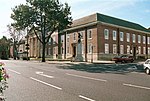Our Lady of Sion School
Our Lady of Sion School is an inter-denominational, independent school for male and female students, founded in 1862 and located in Worthing, West Sussex, on the south coast of England. Based on the teachings of Theodor Ratisbonne and Alphonse Ratisbonne, the school is part of a worldwide network of schools founded by the Sisters of Sion. Other Sion Schools can be found in Australia, Canada, Brazil, Costa Rica, France, Turkey, and the United States. The Senior School is situated partially upon the site of the original convent, whilst the Junior School, a conversion of a large Victorian home, is located three roads away. The school's current Headteacher is Mr Steven Jeffery. The school motto is Consideration Always.
Excerpt from the Wikipedia article Our Lady of Sion School (License: CC BY-SA 3.0, Authors).Our Lady of Sion School
Gratwicke Road,
Geographical coordinates (GPS) Address Phone number Website Nearby Places Show on map
Geographical coordinates (GPS)
| Latitude | Longitude |
|---|---|
| N 50.813 ° | E -0.3771 ° |
Address
Our Lady of Sion Senior School
Gratwicke Road
BN11 4BL , West Worthing
England, United Kingdom
Open on Google Maps










